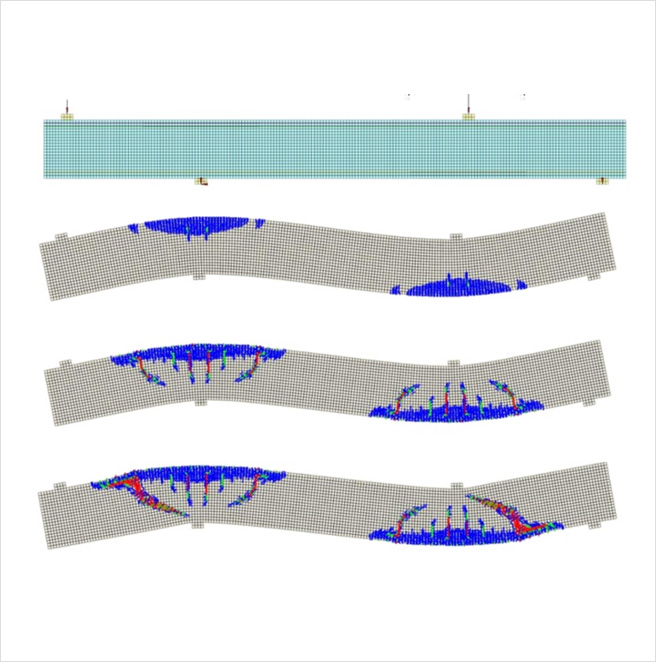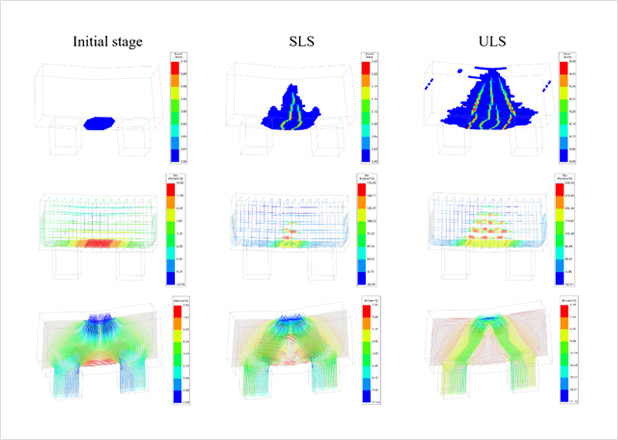소프트웨어
DIANA
Reinforced Concrete
철근 콘크리트의 파괴 해석은 80년대 후반과 90년대에 유럽과 미국 및 일본의 주된 연구 분야였습니다. 균열과 콘크리트 파괴의 수학적 모델이 개발되었으며, 실험을 통해 검증되었습니다. DIANA는 연구기관과의 콘소이움을 통해 콘크리트 균열에 대한 수학적 모델과 개발 및 검증 개념에 대한 수학적 플렛폼으로서 사용되었습니다. 이것은 DIANA가 철근 콘크리트 구조물의 파괴를 분석할 수 있는 기초가 되었습니다.
90년대 후반 네덜란드 정부의 지원을 받아 이러한 개념은 실용적인 구조물에 적용하기 위한 3차원 범용 프로그램의 프레임 작업에 사용될 수 있도록 발전되어 왔습니다. 지난 10년 동안 DIANA의 실용적인 기능들은 사용자 친화성과 성능 측면에서 많은 발전을 이루었습니다.
철근 콘크리트 구조물의 손상 진전해석과 파괴해석의 정확성을 위해서는, 콘크리트와 철근의 서로 다른 재료적 특성을 정확하게 고려해야합니다. DIANA의 철근 콘크리트 모델은 철근과 콘크리트의 정확한 기하학적 정의, 철근과 콘크리트 재료의 파괴, 그리고 두 재료 사이에 연결되 부위의 본드슬립거동에 근거한다. 이는 특정 하중조건이나 하중 이력에 관한 합성 구조의 파괴와 같은 특별한 조건을 모사할 수 없는 일반적인 상태에서의 현상적 거동에 근거한 많은 다른 프로그램들과 차별된다.
DIANA는 구조물의 파괴 해석, 시공단계, 하중 이력, 열하중, 콘크리트 경화, 지반-구조물 상호거동, 동하중과 시간에 따른 재료 변화를 고려한 해석등을 수행할 수 있습니다.
최근에 DIANA는 현대 국제 설계 코드에 다라 3차원 판구조물의 철근 그리드에 대한 설계 체크 기능을 탑재하였습니다. 또한 극한한계상태(Ultimate Limit State)와 사용한계상태(Serviceability Limit State)에 쉽게 접근할 수 있는 기능들이 추가되었습니다. 더욱이, 섬유보강 재료모델을 모사하기 위한 섬유 재료와 콘크리트의 불균질성을 고려한 확률론적 재료모델과 같은 새로운 재료들도 추가되었습니다.
그러므로 DIANA에서는 ULS/SLS에 대한 포괄적인 평가와 철근 구조물에 대한 통합된 파괴 해석을 모두 하나의 프로그램에서 수행할 수 있습니다.

- Embedded reinforcements with grids and bars defined independently from finite element mesh
- Bond-slip reinforcement
- Pre and post tensioning
- Reinforced concrete concept applicable in all element types such as solids, plane stress, plane strain, axi-symmetric, shell and plate elements, beam elements and interface elements.
- Construction-staged analysis for accurate description of loading history
- Staggered and fully coupled heat-stress analysis for thermal effects on loading of structure
- Ambient influence on material behaviour
- Full 3D modeling capabilities with solid elements, shells and beams
- Composed elements which allow to calculating cross-section forces and bending moments in references lines and reference places from compositions of solid and shell elements
- Automatic coupling of different element types
- Reference to material definitions of international design codes
- Mobile loading and influence field analysis
- Easy definition and handling of load combinations and scanning over results from different load cases
- Design checks of reinforcement grids

- Linear elastic anisotropic and orthotropic models
- Nonlinear joints
- Combination with full range of nonlinear material capabilities possible
- Sequential linear analysis for efficient assessment of limit states
- Full 3D modeling capabilities with solid elements, shells and beams to be combined.
- Composed elements which allow to calculate cross-section forces and bending moments in references-lines and reference places from compositions of solid and shell elements
- Automatic coupling of different element types
- Reference to material definitions of international design codes
- Full-loading history and range of loading types can be defined
- Assessment of onset of plastic failure of reinforcement or concrete cracking and crushing
- Stiffness adaption analysis
- Uniaxial stress-strain relations as input for compression and tension for concrete and reinforcements
- Fiber reinforced material models
- Random field material models

